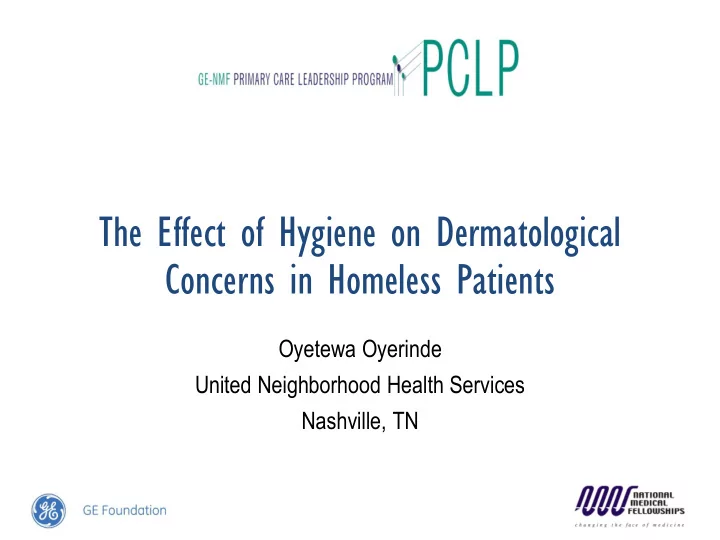

The Effect of Hygiene on Dermatological Concerns in Homeless Patients Oyetewa Oyerinde United Neighborhood Health Services Nashville, TN
Introduction • The aim of this project was to specifically address the skin-related concerns of the homeless population served by the United Neighborhood Health Services (UNHS). By investigating the number of patients that presented to these clinics with dermatological concerns, and specifically those that can be addressed through modification of personal hygiene methods, the project will help inform primary care physicians on how to better counsel their patients.
Background • The Health Care for the Homeless (HCH) Program of 1987 provides funding to Community Health Centers that serve the homeless • Many of the most common dermatological concerns of the UNHS’ homeless patients can be prevented or alleviated by employing effective habits of personal hygiene
Background (ctn) • While shelters are extremely helpful to the homeless population, providing many with a place to sleep, or protection from the weather and environmental elements, they also tend to harbor infectious agents, which lead to skin-related health disorders • Certain chronic diseases, such as diabetes, predispose patients towards skin conditions that are not necessarily associated with hygiene.
Background (ctn) • What percentage of Nashville’s homeless population presents to the UNHS clinic with dermatological complaints? • Of skin related complaints, what percentage are manifestations of systemic diseases or genetics? • Additionally, what percentage can be attributed to method of hygiene and environment?
Objectives • 1) To better understand the dermatological concerns of the homeless population in Nashville. • 2) To determine whether personal hygiene plays a significant role in the skin related conditions of these patients. • 3) To provide a sustainable intervention that can be used by community health centers as a template for future care.
Methodology • The project began by interviewing the physicians at the two homeless clinics, as well as the management team at the homeless shelter. • Each dermatological condition believed to be prevalent in the homeless community by these professionals was researched to learn whether or not it was related to hygienic habits or not. • Using the electronic medical records of these patients, each of their chief complaints and diagnoses were listed.
Methodology (ctn) • Using this data set, the number of conditions that can be prevented or alleviated by proper personal hygiene and a sanitary environment were determined. • A soap and hand sanitizer drive called Soap on Wheels (S.O.W.) was conducted with the hotels and motels around Nashville. • The distribution of these hygiene packets took place at the end of an hour-long hygiene workshop, which took place at a homeless shelter
Results • 102 homeless patients • The majority lived in a homeless shelter HOUSING STATUS 70.00% 60.00% 50.00% 40.00% 30.00% 20.00% 10.00% 0.00% Shelter Streets Transitional Family Other
Results (ctn) • Twenty (19.6 percent) of the 102 patients presented with a dermatological concern as their chief complaint. % of Total Patients Skin Condition Swelling 45% Rash 20% Skin lesion 15% Cellulitis 15% Athletes Foot 5% Dermatophytosis 5% Atopic Dermatitis 5% Skin Graft infection 5% Insect bite 5% Pilonidal abscess 5% Jock Itch 5%
Results (ctn) Past Diagnosis % of Total Patients Dermatitis 29% Dermatophytosis 27% • Forty five of the patients (44.1%) had Cellulitis 20% Local skin infection 8.9% at least one past diagnosis of a Open wound 4.4% Carbuncle 4.4% dermatological disease Atopic dermatitis 2.2% Plantar fibromatosis 2.2% Scabies 2.2% Insect bite 2.2% Pruritis ani 2.2% Viral warts 2.2% Impetigo 2.2% Fascitis 2.2% Decubitus ulcer 2.2% Onychia 2.2% Sebaceous cyst 2.2% Lichen planus 2.2% Blister 2.2% Herpes 2.2%
Results (ctn) • At least 36 (35.3%) of the patients were overweight or obese. • Seventeen patients (16.7%) had Diabetes Mellitus.
Discussion • Of the 11 skin conditions presented by patients as a chief complaint, 7 can be affected by a patient’s personal hygiene (Swelling, Rash, Skin lesions, Cellulitis, Athletes Foot, Dermatophytosis, and Jock Itch). • The results strongly suggest that many of these conditions could be prevented by outreach initiatives on the community health center’s behalf.
Discussion (ctn) • In the future, provide the homeless patients with surveys, in an attempt to gain an in-depth understanding of their opinions on the importance of hygiene and cleanliness, and its role in the skin-care and health outcomes
Recommendations • In the future, S.O.W. can be continued for a longer period of time. Instead of only receiving donations from hotels and motels, donations can also be requested from additional organizations or corporations. • The focus of S.O.W. workshops • Educating the patients about the correlation between their hygiene and the skin’s health • Empowering the patients with the tools they need to be compliant and successful in their endeavors to improve their personal hygiene.
Conclusion • The project helped to inform primary care physicians on how to better counsel their patients. • The interventional portion of this project has provided a sustainable model for addressing hygienic concerns in homeless and other low socio-economic populations.
Acknowledgements • God • Mother • Samantha Haun • William Wyatt, Site Supervisor • William Richie, Faculty Advisor
Recommend
More recommend